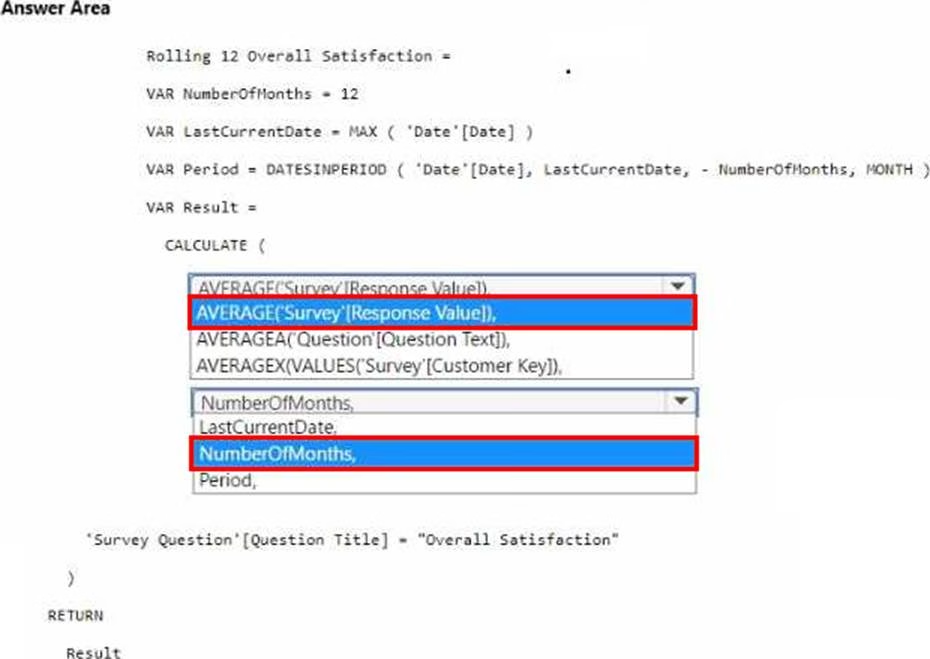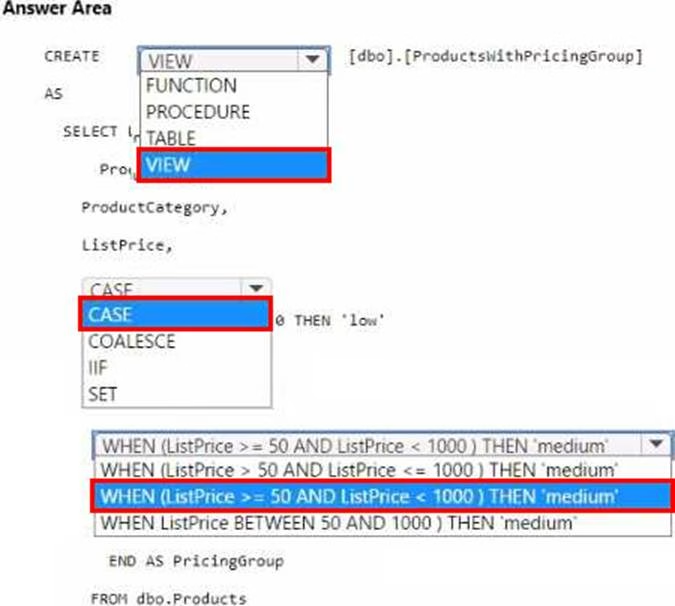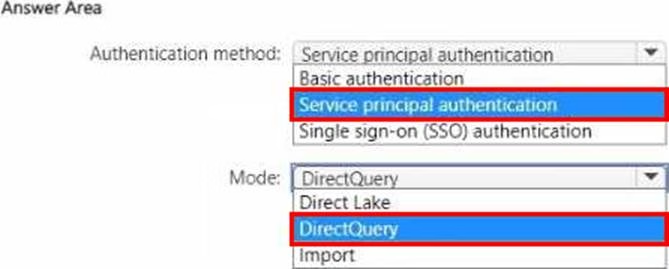Microsoft DP-600 Microsoft Fabric Analytics Engineer Online Training
Microsoft DP-600 Online Training
The questions for DP-600 were last updated at Oct 26,2025.
- Exam Code: DP-600
- Exam Name: Microsoft Fabric Analytics Engineer
- Certification Provider: Microsoft
- Latest update: Oct 26,2025
Topic 1, Contoso Case Study
Overview
Litware. Inc. is a manufacturing company that has offices throughout North America. The analytics team at Litware contains data engineers, analytics engineers, data analysts, and data scientists.
Existing Environment
litware has been using a Microsoft Power Bl tenant for three years. Litware has NOT enabled any Fabric capacities and features.
Fabric Environment
Litware has data that must be analyzed as shown in the following table.
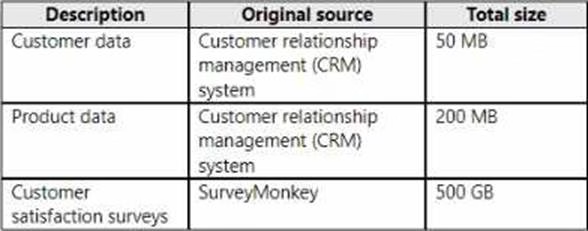
The Product data contains a single table and the following columns.

The customer satisfaction data contains the following tables:
• Survey
• Question
• Response
For each survey submitted, the following occurs:
• One row is added to the Survey table.
• One row is added to the Response table for each question in the survey.
The Question table contains the text of each survey question. The third question in each survey response is an overall satisfaction score. Customers can submit a survey after each purchase.
User Problems
The analytics team has large volumes of data, some of which is semi-structured. The team wants to use Fabric to create a new data store.
Product data is often classified into three pricing groups: high, medium, and low. This logic is implemented in several databases and semantic models, but the logic does NOT always match across
implementations.
Planned Changes
Litware plans to enable Fabric features in the existing tenant. The analytics team will create a new data store as a proof of concept (PoC). The remaining Litware users will only get access to the Fabric features once the PoC is complete. The PoC will be completed by using a Fabric trial capacity.
The following three workspaces will be created:
• AnalyticsPOC: Will contain the data store, semantic models, reports, pipelines, dataflows, and notebooks used to populate the data store
• DataEngPOC: Will contain all the pipelines, dataflows, and notebooks used to populate Onelake
• DataSciPOC: Will contain all the notebooks and reports created by the data scientists
The following will be created in the Analytics POC workspace:
• A data store (type to be decided)
• A custom semantic model
• A default semantic model
• Interactive reports
The data engineers will create data pipelines to load data to OneLake either hourly or daily depending on the data source. The analytics engineers will create processes to ingest transform, and load the data to the data store in the Analytics POC workspace daily. Whenever possible, the data engineers will use low-code tools for data ingestion. The choice of which data cleansing and transformation tools to use will be at the data engineers’ discretion.
All the semantic models and reports in the Analytics POC workspace will use the data store as the sole data source.
Technical Requirements
The data store must support the following:
• Read access by using T-SQL or Python
• Semi-structured and unstructured data
• Row-level security (RLS) for users executing T-SQL queries
Files loaded by the data engineers to OneLake will be stored in the Parquet format and will meet Delta Lake specifications.
Data will be loaded without transformation in one area of the Analytics POC data store. The data will then be cleansed, merged, and transformed into a dimensional model.
The data load process must ensure that the raw and cleansed data is updated completely before populating the dimensional model.
The dimensional model must contain a date dimension. There is no existing data source for the date dimension. The Litware fiscal year matches the calendar year. The date dimension must always contain dates from 2010 through the end of the current year.
The product pricing group logic must be maintained by the analytics engineers in a single location. The pricing group data must be made available in the data store for T-SQL queries and in the default semantic model.
The following logic must be used:
• List prices that are less than or equal to 50 are in the low pricing group.
• List prices that are greater than 50 and less than or equal to 1,000 are in the medium pricing group.
• List pnces that are greater than 1,000 are in the high pricing group.
Security Requirements
Only Fabric administrators and the analytics team must be able to see the Fabric items created as part of the PoC. Litware identifies the following security requirements for the Fabric items in the Analytics POC workspace:
• Fabric administrators will be the workspace administrators.
• The data engineers must be able to read from and write to the data store. No access must be granted to datasets or reports.
• The analytics engineers must be able to read from, write to, and create schemas in the data store. They also must be able to create and share semantic models with the data analysts and view and modify all reports in the workspace.
• The data scientists must be able to read from the data store, but not write to it. They will access the data by using a Spark notebook.
• The data analysts must have read access to only the dimensional model objects in the data store. They also must have access to create Power Bl reports by using the semantic models created by the analytics engineers.
• The date dimension must be available to all users of the data store.
• The principle of least privilege must be followed.
Both the default and custom semantic models must include only tables or views from the dimensional model in the data store.
Litware already has the following Microsoft Entra security groups:
• FabricAdmins: Fabric administrators
• AnalyticsTeam: All the members of the analytics team
• DataAnalysts: The data analysts on the analytics team
• DataScientists: The data scientists on the analytics team
• Data Engineers: The data engineers on the analytics team
• Analytics Engineers: The analytics engineers on the analytics team
Report Requirements
The data analysis must create a customer satisfaction report that meets the following requirements:
• Enables a user to select a product to filter customer survey responses to only those who have purchased that product
• Displays the average overall satisfaction score of all the surveys submitted during the last 12 months up to a selected date
• Shows data as soon as the data is updated in the data store
• Ensures that the report and the semantic model only contain data from the current and previous year
• Ensures that the report respects any table-level security specified in the source data store
• Minimizes the execution time of report queries
HOTSPOT
You to need assign permissions for the data store in the Analytics POC workspace. The solution must meet the security requirements.
Which additional permissions should you assign when you share the data store? To answer, select the appropriate options in the answer area. NOTE: Each correct selection is worth one point.
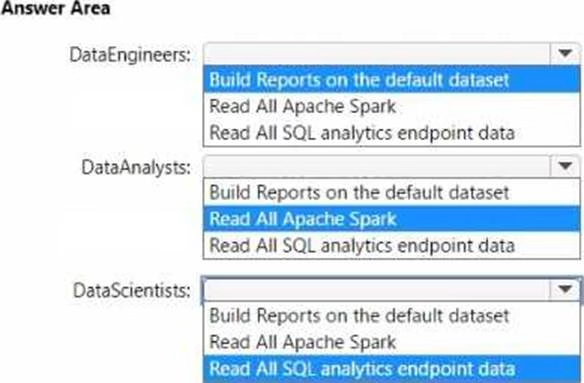
HOTSPOT
You need to create a DAX measure to calculate the average overall satisfaction score.
How should you complete the DAX code? To answer, select the appropriate options in the answer area. NOTE: Each correct selection is worth one point.
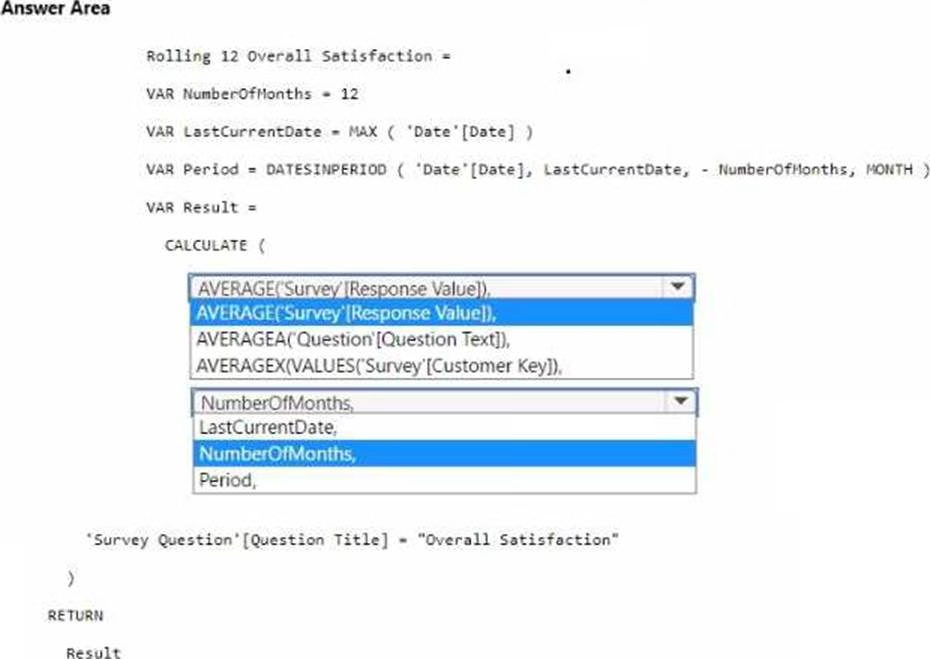
HOTSPOT
You need to resolve the issue with the pricing group classification.
How should you complete the T-SQL statement? To answer, select the appropriate options in the answer area. NOTE: Each correct selection is worth one point.
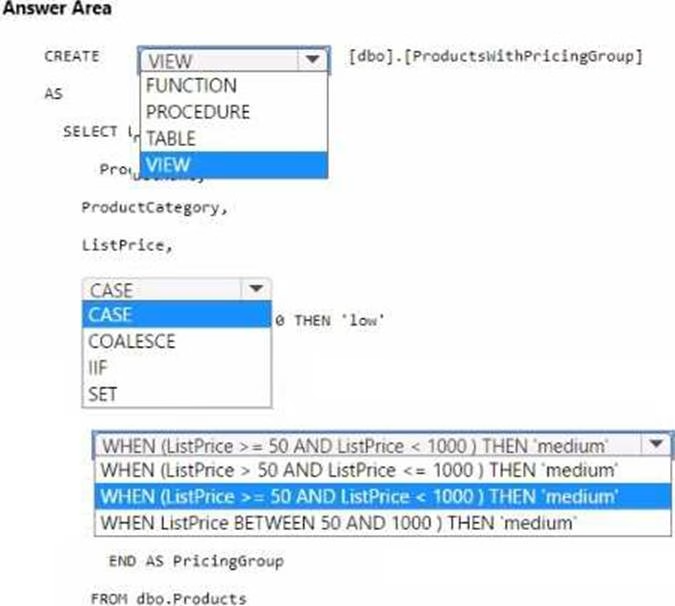
What should you recommend using to ingest the customer data into the data store in the AnatyticsPOC workspace?
- A . a stored procedure
- B . a pipeline that contains a KQL activity
- C . a Spark notebook
- D . a dataflow
Which type of data store should you recommend in the AnalyticsPOC workspace?
- A . a data lake
- B . a warehouse
- C . a lakehouse
- D . an external Hive metaStore
You need to recommend a solution to prepare the tenant for the PoC.
Which two actions should you recommend performing from the Fabric Admin portal? Each correct answer presents part of the solution. NOTE: Each correct answer is worth one point.
- A . Enable the Users can try Microsoft Fabric paid features option for specific security groups.
- B . Enable the Allow Azure Active Directory guest users to access Microsoft Fabric option for specific security groups.
- C . Enable the Users can create Fabric items option and exclude specific security groups.
- D . Enable the Users can try Microsoft Fabric paid features option for the entire organization.
- E . Enable the Users can create Fabric items option for specific security groups.
You need to ensure the data loading activities in the AnalyticsPOC workspace are executed in the appropriate sequence. The solution must meet the technical requirements.
What should you do?
- A . Create a pipeline that has dependencies between activities and schedule the pipeline.
- B . Create and schedule a Spark job definition.
- C . Create a dataflow that has multiple steps and schedule the dataflow.
- D . Create and schedule a Spark notebook.
You need to implement the date dimension in the data store. The solution must meet the technical requirements.
What are two ways to achieve the goal? Each correct answer presents a complete solution. NOTE: Each correct selection is worth one point.
- A . Populate the date dimension table by using a dataflow.
- B . Populate the date dimension table by using a Stored procedure activity in a pipeline.
- C . Populate the date dimension view by using T-SQL.
- D . Populate the date dimension table by using a Copy activity in a pipeline.
HOTSPOT
You need to design a semantic model for the customer satisfaction report.
Which data source authentication method and mode should you use? To answer, select the appropriate options in the answer area. NOTE: Each correct selection is worth one point.
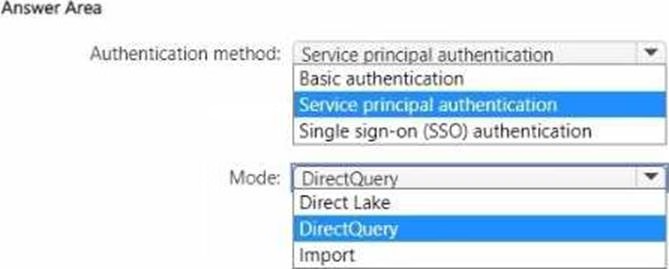
Topic 2, Contoso, ltd.
Overview
Contoso, ltd. is a US-based health supplements company, Contoso has two divisions named Sales and Research. The Sales division contains two departments named Online Sales and Retail Sales. The Research division assigns internally developed product lines to individual teams of researchers and analysts.
Identity Environment
Contoso has a Microsoft Entra tenant named contoso.com. The tenant contains two groups named ResearchReviewersGroupi and ReseachReviewefsGfoup2.
Data Environment
Contoso has the following data environment
• The Sales division uses a Microsoft Power B1 Premium capacity.
• The semantic model of the Online Sales department includes a fact table named Orders that uses import mode. In the system of origin, the OrderlD value represents the sequence in which orders are created.
• The Research department uses an on-premises. third-party data warehousing product.
• Fabric is enabled for contoso.com.
• An Azure Data Lake Storage Gen2 storage account named storage1 contains Research division data for a product line named Producthne1. The data is in the delta format.
• A Data Lake Storage Gen2 storage account named storage2 contains Research division data for a product line named Productline2. The data is in the CSV format.
Planned Changes
Contoso plans to make the following changes:
• Enable support for Fabric in the Power Bl Premium capacity used by the Sales division.
• Make all the data for the Sales division and the Research division available in Fabric.
• For the Research division, create two Fabric workspaces named Producttmelws and Productline2ws.
• in Productlinelws. create a lakehouse named LakehouseV
• In Lakehouse1. create a shortcut to storage1 named ResearchProduct.
Data Analytics Requirements
Contoso identifies the following data analytics requirements:
• All the workspaces for the Sales division and the Research division must support all Fabric experiences.
• The Research division workspaces must use a dedicated, on-demand capacity that has per-minute billing.
• The Research division workspaces must be grouped together logically to support OneLake data hub filtering based on the department name.
• For the Research division workspaces, the members of ResearchRevtewersGroupl must be able to read lakehouse and warehouse data and shortcuts by using SQL endpoints.
• For the Research division workspaces, the members of ResearchReviewersGroup2 must be able to read lakehouse data by using Lakehouse explorer.
• All the semantic models and reports for the Research division must use version control that supports branching
Data Preparation Requirements
Contoso identifies the following data preparation requirements:
• The Research division data for Producthne2 must be retrieved from Lakehouset by using Fabric notebooks.
• All the Research division data in the lakehouses must be presented as managed tables in Lakehouse explorer.
Semantic Model Requirements
Contoso identifies the following requirements for implementing and managing semantic models;
• The number of rows added to the Orders table during refreshes must be minimized.
• The semantic models in the Research division workspaces must use Direct Lake mode.
General Requirements
Contoso identifies the following high-level requirements that must be considered for all solutions:
• Follow the principle of least privilege when applicable
• Minimize implementation and maintenance effort when possible.
Which syntax should you use in a notebook to access the Research division data for Productlinel?
A)
![]()
B)
![]()
C)
![]()
D)
![]()
- A . Option A
- B . Option B
- C . Option C
- D . Option D
Latest DP-600 Dumps Valid Version with 55 Q&As
Latest And Valid Q&A | Instant Download | Once Fail, Full Refund


